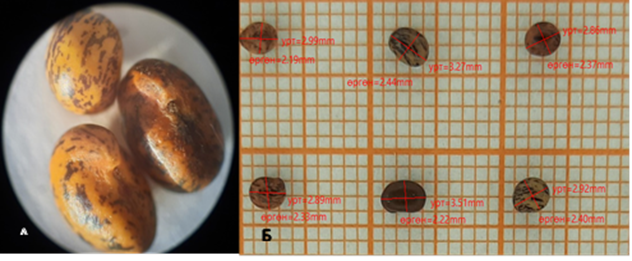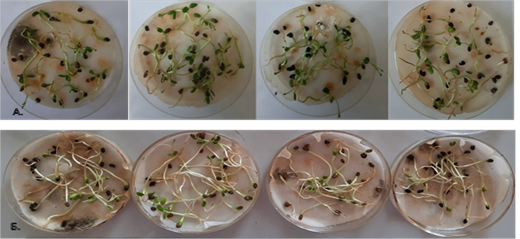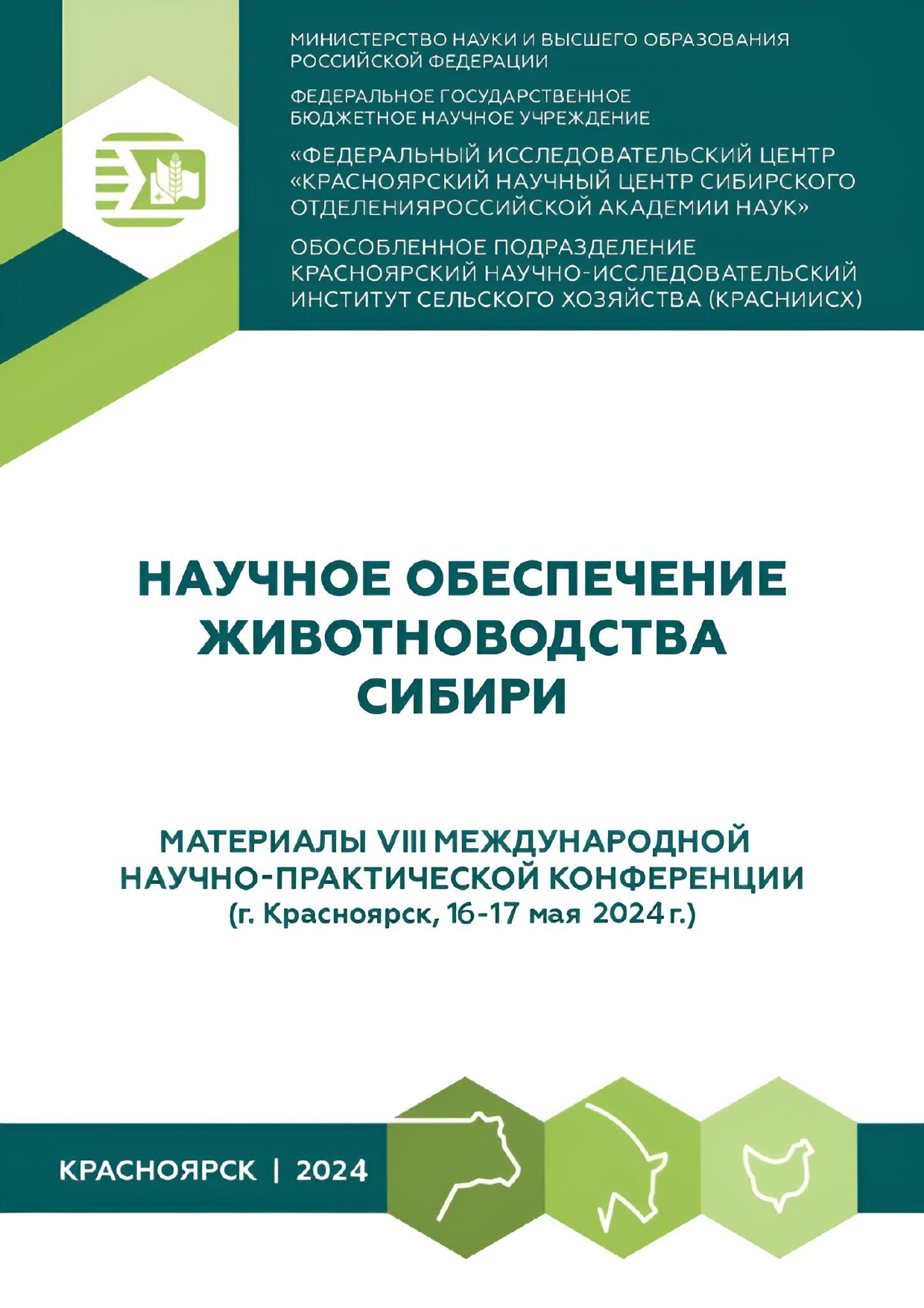Россия
Семена Caragana leucophloea характеризуются овально-округлой формой, длиной 2,9 мм и шириной 2,24 мм. При массе 7,6 г на 1000 семян они имеют оттенки от коричнево-желтого до желтого. Глазок семени расположен внутри спутанной части семени, поверхность гладкая, с многочисленными продольными полосами и темными пятнами. В контролируемых лабораторных условиях при +20°С всхожесть семян достигала 85%, со скоростью роста 5 дней и в среднем 2 ростками в сутки. И наоборот, при +25°C всхожесть семян увеличивалась до 88%, что сопровождалось более быстрым ростом на 4 дня и сохранением в среднем 2 ростков в день.
морфология семян, всхожесть, скорость роста, равномерность роста
Introduction. In the genus Caragana Lam, about 80-100 species are distributed in the temperate and dry-cool regions of Eastern Europe and Asia [11], while 18 species are distributed in Mongolia [7].
It is distributed in Mongolia's Khangai, Mongolia-Dagur mountain forest steppe, Khovd, Mongolia-Altai, Dundad Khalkh steppe districts, Ikhnuur, Olonnuur, Dornogovi, Gobi-Altay mountain desert and Altai Upper Gobi desert districts. It grows on sandy desert plains, dry stony and gravelly sides, the skirts and bottoms of small mountains and hills, river gravels, suri, the edges of sedges, and the edges of the periphery[3].
Among the species of the genus, Caragana arborescens Lam is mostly used for decoration, while other species are not used as much. Hargan is eaten well by camels and moderately by small livestock, but it is also the main fodder for herds during droughts. The small animals that eat the flowers in the spring get milk, and they get sick faster [5]. It enriches and improves the soil with nitrogen, while inhibiting the migration of sand and reducing soil erosion. Therefore, it is possible to plant and use it for mining rehabilitation, animal feed and decoration purposes [6].
Regeneration of goldenrod by seeds and overwintering buds has been reported, but there is little evidence of seed germination under laboratory conditions. Therefore, we recorded the morphological characteristics of the seeds of this plant, germinated them at different temperatures in the laboratory, and determined the characteristics of germination, such as seed germination, growth rate, and growth uniformity.
Materials and methods. In a study conducted using seed samples collected in 2021 from the Umnogovi province area, seed morphology and laboratory germination were analyzed at the "Plant Anatomy and Stress Physiology Laboratory" of the Mongolian University of Life Science (MULS).
Following standard methodology for seed morphology analysis [1,10], various tools were employed, including binoculars, magnifying glass, an Olympus microscope, a camera, ToupView 3.7 software, and paper with a millimeter scale. Key parameters such as seed shape, size, color, surface, and sexual position were determined. Seeds were extracted from pods, cleaned, and weighed using an analytical balance with a precision of 0.001 gram in four repetitions, with 1000 seeds weighed for accuracy. For seed measurement, 30 seeds were selected, photographed with a digital camera, and measured using ToupView 3.7 software. Quantitative parameters were defined in Excel through data analysis [4].
Seed germination was tested under two scenarios: and Scenario II, at +25°C, each replicated four times in Petri dishes over a period of 10-14 days [1,2]. Germinated seeds were counted, and germination percentage (%), growth rate, and uniformity were calculated using the following formulas. It includes:
 (1)
(1)
where: Тspeed – Growth rate, days;
t – Average germination, time;
N-t – Number of seeds germinated per day.

where: Tuniformity – Growth uniformity, pieces;
ntotal – Total number of germinated seeds;
ttotal – Total germination time [2].
Results. The seeds of Caragana leucophloea Pojark exhibit an oval-round shape, measuring 2.38-3.75 (with a mean length of (2.95 ± 0.05) mm in length and 1.95-2.89 (with a mean width of 2.24 ± 0.03) mm. They weigh approximately 7.6 gr per 1000 seeds and display a brown-yellow coloration, sometimes leaning towards yellow. The seed hilum is situated within the tangled portion of the seed, while its surface appears smooth with numerous longitudinal stripes and dark spots, as depicted in Figure 1.

Figure1 – Seed morphology and size of Caragana leucophloea
А. Seed shape Б. Seed size
The results of the laboratory germination of Caragana leucophloea seeds are shown in a table (Table No. 1), and the state of germination is shown in a picture (Figure 2).
Results of seed germination studies
Table1.
|
№ |
Name of plant |
Аt a thermostat of +20°C |
Аt a thermostat of +25 |
||||
|
Germi-nation, % |
Growth rate, days |
Growth uniformity, pieces |
Germi-nation, % |
Growth rate, days |
Growth uniformity, pieces |
||
|
1. |
Caragana leucophloea |
85 |
5.45 |
2.26 |
88 |
4.1 |
2.92 |

Figure2 – Seed germination of Caragana leucophloea
А. Seed germination at a thermostat of +20°C
Б. Seed germination at a thermostat of +25°C
Based on the research findings, it was observed that the Golden Crow seeds exhibited robust root and shoot development at temperatures ranging from +20 to +25°C, achieving a notable germination rate of 85-88%. Hence, this temperature range was deemed optimal for seed germination.
Disсussion. The Golden Grouse holds significant potential for enhancing pastures and rangelands, serving as a crucial component in both the arid steppes and desert steppes. Moreover, it serves as a valuable raw material for mixed feed production [5].
In China, extensive land clearing initiatives are undertaken annually to combat desertification. Recently, cooperation between Mongolian communities from the South and Inner Mongolia's Hyangan Provinces has emerged, aiming to cultivate Caragana leucophloea in Mongolia's Dundgovi Province and safeguard grasslands against desertification. As part of this collaboration, it was decided to plant Golden Grouse seeds in the Delgertsogt and Ulziit districts of Dundgovi Province. [12].
Research conducted in Xinjiang on Caragana leucophloea and C.aurantiaca seeds revealed that optimal germination temperatures range between 15-30°C. Furthermore, experiments involving different concentrations of NaCl solutions for germination demonstrated that while seeds failed to germinate under saline conditions, watering with distilled water preserved germination capacity, albeit at a slower rate. [8]
The widespread utilization of Caragana species in afforestation efforts across arid and semi-arid regions of China is attributed to their rapid seed germination in low-rainfall conditions. Comparative studies on six Caragana species grown in varied annual rainfall environments highlighted distinct differences in seed coat structures. Seeds from species thriving in low rainfall environments exhibited enhanced water absorption and faster germination rates compared to those from high rainfall environments. [8]
Seed germination is recognized as a pivotal factor in species dispersal, influenced by both phylogenetic constraints and environmental conditions. Temperature and humidity play vital roles in seed germination, with the seed coat structure and ecological adaptation of the species further influencing germination dynamics. [10]
Based on our research findings, preliminary conclusions suggest that Golden Grouse seeds can be successfully planted in desert regions at temperatures ranging from 20-25°C, taking into account the species' growth environment and seed coat characteristics.
Conclusion. Caragana leucophloea seeds are characterized by an oval-round shape, measuring 2.9 mm in length and 2.24 mm in width. With a weight of 7.6 g per 1000 seeds, they exhibit hues ranging from brown-yellow to yellow. The seed hilum is situated within the entangled part of the seed, while the surface appears smooth with numerous longitudinal stripes and dark spots.
In controlled laboratory conditions at +20°C, seed germination reached 85%, with a growth rate of 5 days and an average of 2 sprouts per day. Conversely, at +25°C, seed germination increased to 88%, accompanied by a faster growth rate of 4 days and maintaining an average of 2 sprouts per day.
Based on these observations, a preliminary conclusion suggests that sowing Caragana leucophloea seeds in desert areas with air temperatures ranging from +20 to +25°C, particularly where early spring warming and late autumn cooling prevail, holds promise for successful cultivation.
1. Binderiya, G. (2016). Seed morphology, anatomy and embryology of some species of Berberidaceae Juss. Thesis of doctor degree. UB, Mongolia.
2. Ganbaatar, S. (2016). Seed Science. UB. Soyombo printing LLC. p.15, 21, 72-78, 127, 142.
3. Grubov, В.I. (2008). Key to the Vascular Plants of Mongolia. Editor. Jamsran,Ts. UB. National University of Mongolia “Development fund”. x.222.
4. Jambaldorj, J. (2003). Datanalysis and Solver programs. Mongolian state university of Agriculture. UB.
5. Jigjidsuren, S., Жонсон, D.A., (2003). Fodder plants of Mongolia. UB. Admon LLC. х-378, 399.
6. Jalbaa, Kh., Tsognamsrai, D. (2010). А guide to growing Caragana. “Munkhiin useg” LLC. UB.p.7-10.
7. Ligaa,U. (2015). Medicinal plants of Mongolia and their use in traditional medicine. Bomanical institute of Academy of Sciences. UB. p.397.
8. MIAO Hao-cui; LIU., Bo; DENG., Jiang-yu; SON., Bin; HUANG., Jun-hua. (2009). Characteristics of Seed Germination of the Two Caragana L. Speicies in Xinjiang. Xinjiang Agricultural Sciences. China. ISSN1001-4330. http://www.xjnykx.com/EN/abstract/abstract2720.shtml
9. Tserenbaljid, G. (2013). A color album of the seeds of extremely rare, rare and useful plants of Mongolia. UB.Mongolia. p.1-82.
10. Ya‑Xian Du., Xue‑Qian Tian., Feng‑Ping Li., Xue‑Rong Li., Xiang‑Wen Fang. (2023). The Mechanisms of rapid seed germination in Caragana species adapted to low mean annual.Trees. https://doi.org/10.1007/s00468-023-02395-4.






